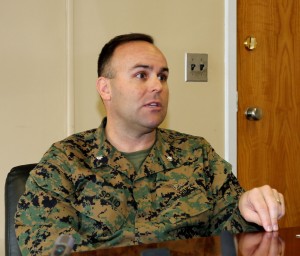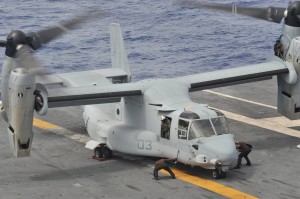2014-03-21 During the visit of the Second Line of Defense team to New River on February 10, 2014, we had a chance to sit down with Lt. Col. Spaid to discuss his experience with the Osprey, the MEU, and the way ahead.
Lt. Col. Spaid is taking over at the CO of VMM-365, the Blue Knights, later this Spring. He started with Ospreys in 2005 and his background is with CH-46s. He was deployed on the first MEU, which worked with the Osprey in 2009, and now he is returning to sea with the 24th MEU this Fall.
In the interview, he discussed his experience with how the USMC introduced the Osprey, and has evolved the capability over time, and how the Osprey experience is being leveraged to prepare for the introduction of the CH-53K.
The pattern of innovation seen with the Osprey should almost certainly be repeated with both the F-35B and the CH-53K, whereby the assets are introduced, baby steps taken to get use to the aircraft, then to evolve the tactical understanding of the asset, and adjust the software to the evolution of tactics as well.
And in the course of all this, the fly by wire airplanes and their digital systems will allow a new approach to maintenance and mission planning.
Lt. Col. Spade described his first deployment with the MEU as follows: “we gently eased in the aircraft, and learned its capabilities and built confidence in the aircraft and began to shape new tactics for the use of the aircraft.”

As he was preparing for the engagement with the 24th MEU, much has changed. “We now have matured tactics and the aircraft itself. We are leveraging the range, speed and capabilities of the aircraft as a ground assault vehicle.”
During all of this evolution, the software has changed as well. He described the Osprey as a highly computerized and automated aircraft. He described the major shift from the CH-46 as a mechanical system to the Osprey as a digital one.
“A key element of the transition from the CH-46 to the Osprey as one of a significant shift in cockpit management and systems with the digitalized Osprey.”
Software in the aircraft has evolved over time and “if you have been out of the cockpit for 24 months, you come back to the squadron for retraining.”
The software evolves and with each upgrade, new publications are released explaining the changes and preparing the pilots and maintainers for the next phase.

“By and large, the upgrade process is relatively seamless, but obviously some upgrades are more drastic than others.”
The aircraft has improved over time as the automated systems perform better and the operators gain more confidence in the performance of the aircraft.
“The ice protection systems are now better and a major change is the coupled mode whereby we fly close to the ground can really leverage automation. We can fly from very far out and hover off the ground by using the automated flight systems. This is a major operational advantage when coming into the objective area in supporting the Ground Combat Element.”
A key aspect of the impact of automation and digital systems is how maintenance is conducted.
“The maintenance profile has shifted from mechanics to avionics. And the plane now has a flight history which is downloaded and the maintainers can directly examine the flight performance to determine repairs which need to be done.”
Another aspect of having digital systems tracking the flight envelope and flight experience is the ability to turn that data over to mission planners who can then use that information to plug into mapping software to determine the nature of the operational trajectory and battlespace experience surrounding the actual flight experience of that aircraft.
An additional impact of the Osprey is preparing more effectively for the introduction of the replacement for the CH-53E, namely the CH-53K.
“The Osprey is the first of its kind to incorporate fly by wire technology. VMX-22 has a CH-53E cell helping with the transition and many of these are from the Osprey community.
We had a big leap from the CH-46 to the Osprey with the new fly by wire experience; it should be easier with the K in part because of having gone through the Osprey transition.”

